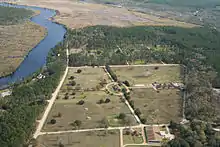| White Oak Conservation | |
|---|---|
 | |
| Date opened | 1982 |
| Location | Yulee, Florida |
| Land area | 17,000 acres (6,900 ha) |
| No. of animals | 400+ |
| No. of species | 32 |
| Website | www |
White Oak Conservation, which is part of Walter Conservation, is a 17,000-acre (6,900 ha) conservation center in northeastern Florida. It has long been dedicated to the conservation of endangered and threatened species, including rhinoceros, okapi, bongo antelope, zebras, dama gazelles, and cheetahs.
Through Walter Conservation, the Walter family conserves rare species and wild places around the world. Efforts include improving the quality of life of individual animals, recovering rare species, restoring ecosystems, and protecting wilderness areas. Thus far, their philanthropy protects important areas in North America and Africa, protecting important wild populations of African elephants, rhinos, lions, and many other species. The Walter Conservation approach is to protect and preserve large wild areas, provide wildlife security and management, to collaborate with local residents and host-country governments, and to invest in sustainable enterprises.
White Oak is well known in the conservation and zoo communities for its rhinoceros, cheetah, and okapi (a rare giraffe relative) programs and for its support of conservation in Africa, Asia, and the United States.[1]
History of White Oak

The earliest recorded history of White Oak Plantation dates back to April 16, 1768, when the British governor of Florida gave land along the St. Marys River through a land grant to Andrew Way, his deputy surveyor of lands. Three years later, Jermyn Wright, also a recipient of a land grant on the St. Marys, purchased Way's property.[2]
The plantation produced timber and was home to food stores for naval vessels using the river. After removing the stands of cypress from the property's swampy areas, Wright also began to cultivate rice, establishing the southernmost rice plantation on the Atlantic coast.[2]
By 1833, Zephaniah Kingsley, a pre-Civil War agricultural baron, had become the plantation's owner. In 1842, White Oak Plantation was purchased by Abraham Bessent, a shopkeeper in nearby St. Marys, Georgia. The sale included extensive machinery and 118 slaves, 109 whose names were recorded on the deed.[2]
Before the American Civil War, White Oak had about 350 acres (140 ha) of rice paddies in cultivation. Today, the abandoned paddies are still visible, and the remnants of a building from the Kingsley era still stand in what is now a cheetah enclosure. During the Civil War, most planters left their rice plantations and permanently relocated to their summer estates. It is probable that the plantation was abandoned at this time.[2]

The Gilman family acquired the property in the late 1930s. Isaac Gilman grew from humble beginnings, peddling in Manhattan in the 1880s after emigrating from Europe. He saved up, and in 1907, he purchased a struggling paper company in Vermont, which was renamed the Gilman Paper Company in 1921.[3]
Gilman handed off the business to his son, Charles, who in 1939 moved it to the 7,400-acre (3,000 ha) White Oak site that was acquired a year earlier and constructed a large paper operation.[3] Early features included timber production; the breeding, raising, and training of horses; and recreational programs that helped market the company, which became the largest private paper business in the country.[2]
Charles Gilman died in 1967, leaving his sons Chris and Howard to run it as president and senior officer, respectively. Chris died in 1982, making Howard the sole owner. It was then that Howard Gilman began to spearhead additions to the White Oak property, investing $154 million to build the Baryshnikov Dance Studio, a conference center, a nine-hole golf course, and expansive enclosures and buildings to raise, breed, rehabilitate, and study threatened and endangered species. (White Oak had animals, like roan antelope, before 1982, but it was that year the center officially became White Oak Conservation Center.) Outside of White Oak, Gilman also made large contributions to the Metropolitan Museum of Art and Brooklyn Academy of Music.[3]
Starting in 1993, the Howard Gilman Foundation hosted a variety of national and international conferences and seminars at White Oak directly related to its three fields of interest: arts and culture, conservation and the environment, and public policy. The foundation—created by Gilman in 1981 to support the arts and wildlife[4]—owned White Oak following Howard Gilman's death in 1998 until March 2013.[2]
In March 2013, White Oak was purchased by Mark and Kimbra Walter. The Walters are conservationists who support wildlife programs across North America. White Oak operations and facilities are managed by White Oak Conservation Holdings LLC, which the Walters established for this purpose.[2]
Animals

White Oak has been successful in breeding, researching, and conserving a wide variety of species.[5] Almost all of the wild population decreases of the imperiled species conserved at the center can be attributed to habitat loss, farming, and poaching.[6]
White Oak is prominent in the zoological world, providing offspring to conservation breeding programs throughout the U.S. and the world.[7][8][9] White Oak also contributes to wildlife research and field conservation programs that have aided in the survival of several rare species.
References
- ↑ "White Oak Conservation - Animal Conservation in Yulee, Florida". White Oak Conservation. Retrieved September 30, 2020.
- 1 2 3 4 5 6 7 "White Oak History". Retrieved June 3, 2013.
- 1 2 3 Lenzner, Robert; Kellner, Tomas (August 11, 2003). "The Fall of The House of Gilman". Forbes. Retrieved February 23, 2014.
- ↑ "About Howard Gilman". Howard Gilman Foundation. Retrieved June 3, 2013.
- ↑ "Conservation". Retrieved June 3, 2013.
- ↑ "Animal Programs". Retrieved June 3, 2013.
- ↑ "The Okapi Conservation Project". Houston Zoo. Retrieved June 3, 2013.
- ↑ "Mississippi Sandhill Crane National Wildlife Refuge". U.S. Fish & Wildlife Service. Retrieved June 3, 2013.
- ↑ "www.rarespecies.org/bngoundp.pdf" (PDF). Rare Species Conservation Foundation. Retrieved June 3, 2013.